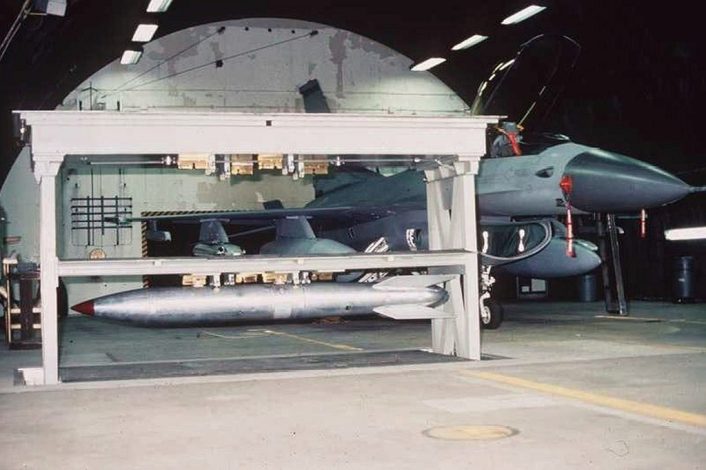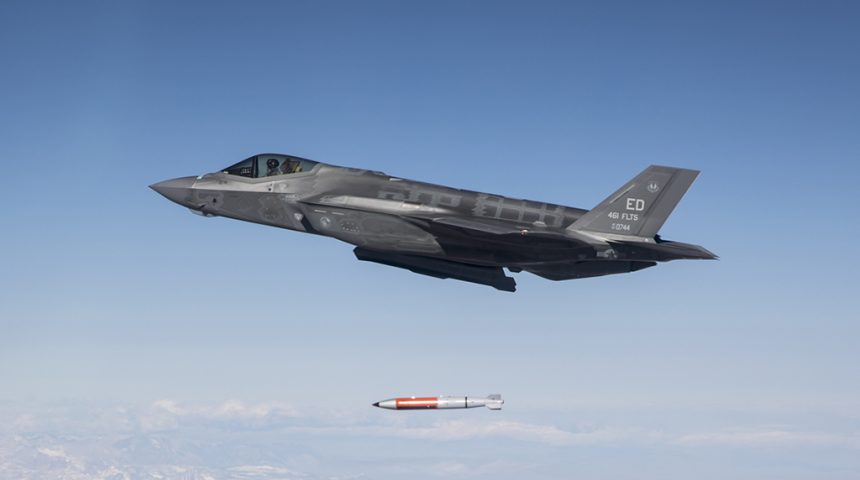The UK has been added again to the list of nuclear weapons storage sites being upgraded in Europe, after 14 years since it last hosted B61 bombs.
A recently published document of the Department of Defense regarding the FY 2023 budget for the Military Construction Program shows the United Kingdom added again to the list of European countries set to receive upgrades to their NATO nuclear weapons storage sites. It is safe to say that the British base hinted in the document is RAF Lakenheath, since it already hosted nuclear weapons in the past to equip the F-15E Strike Eagle.
“NATO funds infrastructure required to store special weapons within secure sites and facilities. NATO is wrapping up a thirteen-year, $384 million infrastructure investment program at storage sites in Belgium, Germany, Italy, the Netherlands, the UK, and Turkey to upgrade security measures, communication systems and facilities”, mentions the document.
“We won’t provide anything on this as it relates to the storage of nuclear weapons.”
UK defense official to @julianborger on “special weapons” storage site in UK. https://t.co/3s2OLUKAfw
At least he confirmed it’s nuclear.
My initial story is here: https://t.co/6uUe4Y9Xz2 pic.twitter.com/PtUdzQmvyN
— Hans Kristensen (@nukestrat) April 12, 2022
According to Hans Kristensen, Director of the Nuclear Information Project at the Federation of American Scientists, “special weapons” refers to the nuclear weapons storage sites and this was seemingly confirmed by British officials when, inquired by reporters from The Guardian, they answered: “We won’t provide anything on this as it relates to the storage of nuclear weapons.”
RAF Lakenheath was reportedly equipped in the 1990s with 33 underground storage vaults used to store nuclear gravity bombs. By the early 2000s, it was assessed that the base might have been hosting a total of 110 B61 gravity bombs, stored there to eventually equip the Strike Eagles of the 48th Fighter Wing. In 2008, Kristensen disclosed that the nuclear weapons had been withdrawn from RAF Lakenheath.
The base has not been in the list of active storage sites for 14 years now and it also was not included in the 2016 contract for the upgrade of the nuclear weapons storage sites in Europe. As mentioned by Kristensen, it is unclear whether nuclear weapons have been returned to the base yet or NATO is upgrading the base to be capable of receiving nuclear weapons in the future if necessary.
It would be totally inappropriate to assume that such a move is related to the current situation in Ukraine and the nuclear threats from Russia, as decisions about these sensitive matters are planned well in advance. The return of the UK in the list of the nuclear storage sites might have been taken even before the beginning of the Russian invasion.
Moreover, let’s not forget that the 48th FW is now receiving brand new F-35s for the “Valkyries” of the 495th Fighter Squadron and, very soon, for the “Grim Reapers” of the 493rd Fighter Squadron. The Lightning II is about to achieve the nuclear design certification, which will allow the 5th gen. aircraft to carry the B61-12 nuclear gravity bomb. Many European countries already operate the F-35 and are expected to use it to replace F-16s and Tornados currently used to fulfill the NATO’s nuclear sharing agreement.

“The B61 series weapons are tactical gravity nuclear weapons that can be used on Dual Capable Aircraft like the F-15E and F-16C/D,” said Lt. Col Daniel Jackson, division chief, Headquarters ACC Strategic Deterrence and Nuclear Integration during one of the most recent tests for the certification. “Having a 5th Generation DCA fighter aircraft with this capability brings an entirely new strategic-level capability that strengthens our nation’s nuclear deterrence mission.”
The B61 entered service 50 years ago and has undergone a Life-Extention Program (LEP) to consolidate and replace four legacy bomb variants, the B61 -3, -4, -7, and -11 mods, into the B61-12. The refurbished B61-12 will allow the retirement of the larger B83, becoming the only remaining gravity delivered nuke in the inventory. The bomb will carry a low-yield nuclear warhead with four yield options, reportedly 0.3 kilotons, 1.5 kilotons, 10 kilotons and 50 kilotons, instead of larger warheads like the models it is replacing (which can reach 400 kilotons depending on the variants).
The 12-foot, 825-pound bomb is designed to be delivered from the air in either ballistic or guided-gravity drop modes, thanks to a new Boeing-built tail assembly that includes an Inertial Navigation System (INS) precision-guidance package and two spin rocket motors that improve the bomb’s stability on its longitudinal axis during the descent. The LEP is said to be increasing the B61’s accuracy so much (with a reported 30 m Circular Error Probability instead of the original 100 m) that it will have the same capability against hardened targets as the much more powerful weapons it is replacing.









